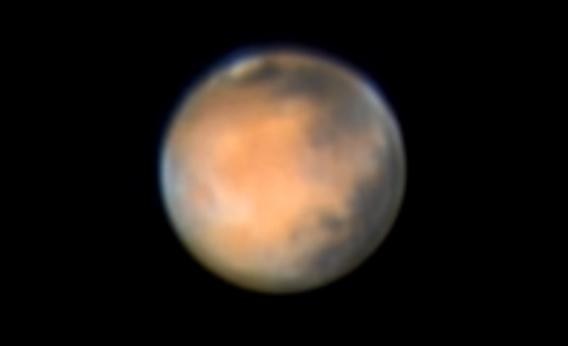Create a free profile to get unlimited access to exclusive videos, sweepstakes, and more!
Mars at Its Best Right Now

Due to the orbital dance of the planets, Mars is currently at its best showing of the year, as close to Earth as it gets, and shining brightly all night long.
To see it, go outside. If it’s after sunset and the sky is dark, face southeast. Look up. There it is. It’s one of the brightest objects in the sky and shines with an orange-y glow.
The technical term for Mars’ place in the sky right now is opposition because it is opposite (literally, 180° around the sky) from the Sun. The Sun sets in the west, so after sunset look east. At midnight, when the Sun is lowest, Mars is at its highest. And closer to dawn as the Sun begins to rise in the east Mars will be sinking in the west.
This also means the Red Planet is as close to our own blue-green one as it gets for a couple of years, so it’s the best time to observe it. Mars is only half the size of the Earth, and more than 90 million kilometers (55 million miles) away, so it’s still rather small through a telescope. Despite that, astrophotographer Christian Fröschlin used his Celestron 8” telescope to observe Mars on April 9, 2014, creating enough images to string together into this amazing video:
Coooool. You can actually see the planet rotate! Mars spins once on its axis in a very Earth-like time of about 24.5 hours (what planetary scientists call a sol to distinguish it from an Earth day), so you’re seeing roughly 1/8th of a sol here. It’s currently summer in the Martian northern hemisphere, so that half of the planet is tipped toward the Sun; that means you’re seeing the north polar ice cap in the video. You can see a bunch more recent images taken of Mars over at Universe Today.
Mars isn’t far from the somewhat fainter orange giant star Arcturus in the sky, and it’s fun to compare them. Also, on Sunday and Monday the full Moon will be only a few degrees away, so that’ll make a good photo op.
If you have clear skies, get outside and look up! The Universe awaits.
Correction, April 10, 2014: Due to a typo I originally listed the distance to Mars as 45 million miles. It is actually 55 million.














